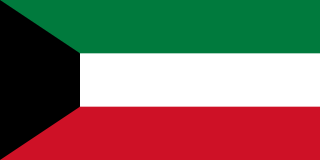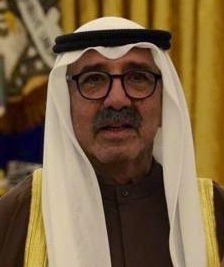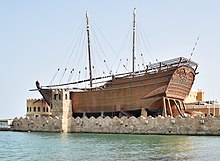
Culture of Kuwait describes the cultural aspects of the Kuwaiti society and is part of the Eastern Arabian culture. Kuwaiti popular culture, in the form of dialect poetry, film, theatre, radio and television soap opera, flourishes and is even exported to neighboring states. Within the Arab states of the Persian Gulf, the culture of Kuwait is the closest to the culture of Bahrain.

Jabriya is in an area in Hawalli Governorate in Kuwait. It is a large, mainly residential area that borders Surra, Hawalli, Salmiya and Bayan.

Kuwait, officially the State of Kuwait, is a country in West Asia. It is situated in the northern edge of Eastern Arabia at the tip of the Persian Gulf, bordering Iraq to the north and Saudi Arabia to the south. With a coastline of approximately 500 km (311 mi), Kuwait also shares a maritime border with Iran. Most of the country's population reside in the urban agglomeration of Kuwait City, the capital and largest city. As of 2023, Kuwait has a population of 4.82 million, of which 1.53 million are Kuwaiti citizens while the remaining 3.29 million are foreign nationals from over 100 countries. In 2024 the population of Kuwait has risen to 4.93 million which is a population increase of 1.98% from 2023.

Zamalek is a qism (ward) within the West District in the Western Area of Cairo, Egypt. It is an affluent district on a man-made island which is geologically a part of the west bank of the Nile River, with the bahr al-a'ma cut during the second half of the 19th Century to separate it from the west bank proper. The northern third has been developed into a residential area, which was home to 14,946 people during the 2017 census. The southern two thirds are mostly sports grounds and public gardens, a stark green reserve in the middle of Cairo.
Jabriya District is one of the districts of Hawalli Governorate in Kuwait.
Mary Bruins Allison was one of the first American women to be trained in medicine in the United States to work as a missionary physician in Arabia. While attending medical college in Philadelphia, she learned Arabic. In 1934, she went to the Middle East to work as a missionary physician. In her forty-year long career, she worked primarily in Kuwait, as well as India, Qatar, Bahrain and Oman. In her capacity in Kuwait, she treated rich and poor women.

Charbel Dagher is a Lebanese professor at the University of Balamand, Koura, Lebanon. He has been an active and prominent voice on the Arab cultural scene, mainly in the fields of poetry, Arabic language, and Arab and Islamic arts. He is a Poet, writer and story-writer in both Arabic and French.

Beit Junblatt is a historic mansion that resides in Aleppo, Syria, built in the 16th century by a Kurdish emir of the Janbulad family.
The Kuwaiti modern art movement emerged in the 1930s, Kuwait has the oldest modern arts movement in the Arabian Peninsula. Kuwait is home to more than 20 art galleries. In recent years, Kuwait's contemporary art scene has boomed. Kuwait has the second most lively gallery scene in the GCC.

The Tareq Rajab Museum is located in Kuwait and houses an extensive collection of artefacts accumulated over a fifty-year period commencing in the 1950s. The Museum is housed at two separate locations in Jabriya, Kuwait. The Tareq Rajab Museum, which was founded in 1980, and the Tareq Rajab Museum of Islamic Calligraphy in 2007. The Tareq Rajab Museum includes collections of manuscripts and miniatures, ceramics, metalwork, glass, arms and armour as well as textiles, costumes and jewellery. The museum's ceramics collection is very large and comprehensive, and includes objects from pre-Islamic times up to the early 20th century and from across the breadth of the Islamic world. The museum houses one of the foremost collections of silver jewellery as well as a fine collection of gold jewellery much of which dates from pre-Islamic times. There is a large collection of Qurans and manuscripts from all periods, with the earliest dating to the 7th century AD and from across the whole Islamic world. From important Qurans, to rare manuscripts such as the Al-Kindi book on optics and a folio from the Shahnameh of Shah Tahmasp, the range of works is comprehensive and representative of many styles and regions.

Dar al Athar al Islamiyyah is a cultural organization operating several cultural centers in Kuwait.
The Kuwait National Cultural District is multibillion-dollar development project that focuses on the arts and culture in Kuwait. With a capital cost of more than US$1 billion, the project is one of the largest cultural investments in the world today. The Kuwait National Cultural District is a member of the Global Cultural Districts Network.
The Sheikh Abdullah Al-Salem Cultural Centre is a cultural complex located in Kuwait City Kuwait, owned by the Amiri Diwan. It consists of six main components; The Natural History Museum, Science Museum, Space Museum, Arabic Islamic Science Museum, Fine Arts Centre and the external spaces known as the Public Realm. The Sheikh Abdullah Al-Salem Cultural Centre is a 18-hectare site making it the world's largest museum complex. The Sheikh Abdullah Al-Salem Cultural Centre was inaugurated in early 2018, it was the world's largest single-delivery museum project.
The Al Salam Palace is a historic palace and museum located in Shuwaikh, Kuwait. It was originally established as an idea envisioned by the late Amir Sheikh Saad Al-Abdullah Al-Salem Al-Sabah in the late 1950s, when he aspired to build a special mansion for him and his family. To achieve that, the late Amir headed to Egypt to search for a specialized architect who could turn his vision of the mansion into reality. He eventually commissioned architect Medhat Al-Abed, who designed a round-shaped palace with magnificent interior decorations. Al Salam Palace is part of the new Kuwait National Cultural District (KNCD).
Al Shaheed Park is the largest urban park in Kuwait, sitting at about 78.5 acres. Al Shaheed Park is considered the most significant green infrastructure project in Kuwait and has one of the largest overstructure greenroofs in the world.

Sheikh Nasser Sabah Al-Ahmad Al-Sabah was the First Deputy Prime Minister, Minister of Defense of Kuwait, and before that he was the head of the Amiri Diwan in 2006–2017. Nasser was the eldest son of the hereditary ruler or Emir of Kuwait, Sabah Al-Ahmad Al-Jaber Al-Sabah (1929–2020). Prior to his death in December 2020, just seventy-two days after his father's death, Nasser was identified as a leading candidate to become the Crown Prince of Kuwait, or the heir apparent. He was a key figure in Kuwait's Vision 2035 plan, which included a planned city in northern Kuwait dubbed "Silk City".
The Shah Jahan Diamond mined from Kollur, Golconda—(currently Hyderabad, India). It is a hololithic flat, table cut 56 carat diamond, used as an amulet—(Tawid'th). In late 1600 AD Mughal Emperor Jahangir gifted it to Prince Shah Jahan—(by his name it is known). Currently it is owned by Dar al Athar al Islamiyyah, Kuwait.
Suʻād Māhir Muḥammad was an Egyptian archaeologist, best known for her work on the Islamic history of Egypt. She was awarded the Order of the Arab Republic of Egypt, second class, in 1977.

Lajvardina-type ceramics were developed in the 13th century following the Mongol invasion of Persia. It was produced throughout the Ilkhanate reign. It is characterized by its deep blue color and often features geometric patterns or foliage inlaid with gold leaf. The style was created using overglaze enamel. An initial layer of dark blue glaze, produced from cobalt, was applied, followed by another layer, often gold, on which the details were painted. It was primarily produced in Kashan, a center for ceramic production and lusterware in the 12th and early 13th centuries. The style was continuously used for tiles and ornamental objects from the 1260s C.E. until the mid-14th century, when production dropped significantly, coinciding with the fall of the Ilkhanate in 1335.













